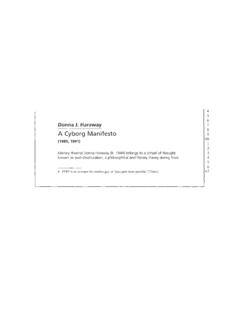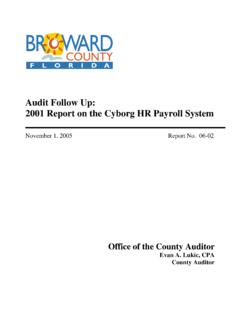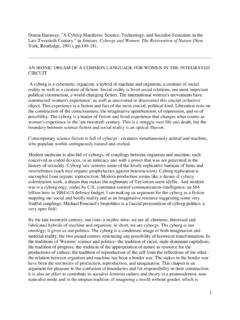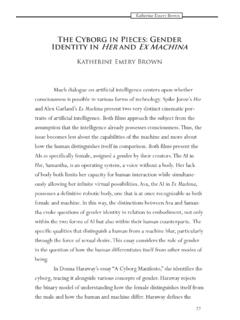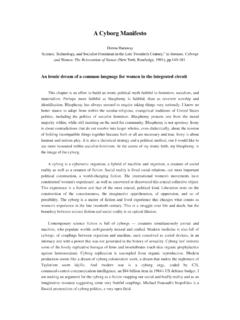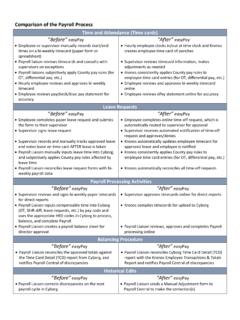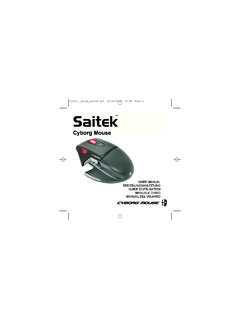Transcription of Cyborgs and space
1 Cyborgs and space Altering man s bodily functions to meet the requirements of extrater- restrial environments would be more logical than providing an earthly environment for him in space .. Artifact-organism systems which would extend man s unconscious, self-regulatory controls are one possibility By Manfred E. Clynes and Nathan S. Kline ROCKLAND STATE HOSPITAL, ORANGEBURG, N. Y. Clynes Kline Manfred E. Clynes has since 1956 been chief research scientist at Rockland State, in charge of the Dynamic Simulation Lab. A graduate of the Univ. of Melbourne, Australia, and holder of an from Juilliard School, he has for the past 10 years been engaged in the design and development of physiological instrumen- tation and apparatus, ultrasonic trans- ducers, and electronic data-processing systems.
2 Nathan S. Kline has been director of re- search at Rockland State since 1952 and an assistant professor of clinical psychia- try at the Columbia Univ. College of Physicians and Surgeons since 1957. Au- thor of more than 100 papers, Dr. Kline holds a New York Newspaper Guild Page One Award in science, the Adolf Meyer Award of the Assn. for Improvement of Mental Health, and the Albert Lasker Award of the American Public Health Assn. This article is baed on a paper pre- sented under the title of Drugs, space and Cybernetics at the .Psychophysio- logical Aspects of Spme Flight Sym- posium sponsored by the AF School of Aviation Medicine in Sun Antonio, Tex.
3 , in May. The complete paper will appear in the Symposium proceedings, to be published by Columbia Univ. Press. space travel challenges mankind not only technologically but also spiritually, in that it invites man to take an active part in his own biological evolution. Scientific advances of the future may thus be utilized to permit man s existence in environments which differ radically from those provided by nature as we know it. The task of adapting man s body to any environment he may choose will be made easier by increased knowledge of homeo- static functioning, the cybernetic aspects of which are just begin- ning to be understood and investigated.
4 In the past evolution brought about the altering of bodily functions to suit different environments. Starting as of now, it will be possible to achieve this to some degree without alteration of heredity by suitable bio- chemical, physiological, and electronic modifications of man s existing modus vivendi. Homeostatic mechanisms found in organisms are designed to provide stable operation in the particular environment of the or- ganism, Examples of three successful alternate solutions pro- vided by biological mechanisms to the body-environment problem with regard to operating temperature are man, hibernating ani- mals, and poikilothermic fish (organisms with blood that take on the temperature of the environment).
5 Various biological solutions have also been developed for an- other problem-respiration. Mammals, fish, insects, and plants each have a different solution with inherent limitations but emi- nently suitable for their field of operation. Should an organism desire to live outside this field, an apparently insurmountable problem exists. However, is the problem really insurmountable? If a fish wished to live on land, it could not readily do so. If, however, a particularly intelligent and resourceful fish could be found, who had studied a good deal of biochemistry and physiology, was a master engineer and cyberneticist, and had excellent lab facilities available to him, this fish could conceivably have the ability to design an instrument which would allow him to live on land and breathe air quite readily.
6 In the same manner, it is becoming apparent that we will in the not too distant future have sufficient knowledge to design instru- 26 Astronautics / September 1960 mental control systems which will make it possible for our bodies to do things which are no less diffi- cult. The environment with which man is now con- cerned is that of space . Biologically, what are the changes necessary to allow man to live adequately in the space environment? Artificial atmospheres encapsulated in some sort of enclosure constitute only temporizing, and dangerous temporizing at that, since we place ourselves in the same position as a fish taking a,small quantity of water along with him to live on.
7 Lalid. The bubble all too easily bursts. The biological ,problems which exist in space travel are many and varied. Long-term space voy- ages, involving flights not of days, months or years, but possibly of several thousand years, will even- tually be hard realities, and resultant physiological and psychological conditions must be considered. These are reviewed below. In some cases, we have proposed solutions which probably could be devised with presently available knowledge and techniques. Other solutions are projections into the future which by their very nature must resemble science fiction. To illustrate, there may be much more efficient ways of carrying out the functions of the respiratory system than by breathing, which be- comes cumbersome in space .
8 One proposed solu- tion for the not too distant future is relatively sim- ple: Don t breathe! If man attempts partial adaptation to space condi- tions, instead of insisting on carrying his whole environment along with him, a number of new pos- sibilities appear. One is then led to think about the incorporation of integral exogenous devices to bring about the biological changes which might be neces- sary in man s homeostatic mechanisms to allow him to live in space qua natura. The autonomic nervous system and endocrine glands cooperate in man to maintain the multiple balances required for his existence. They do this without conscious control, although they are ame- nable to such influence.
9 Necessary readjustments of these automatic responses under extraterrestrial con- ditions require the aid of control theory, as well as extensive physiological knowledge. Cyborg-Frees Man +o Explore What are some of the devices necessary for creat- ing self-regulating man-machine systems? This self- regulation must function without the benefit of consciousness in order to cooperate with the body s own autonomous homeostatic controls. For the exogenously extended organizational complex func- tioning as an integrated homeostatic system uncon- sciously, we propose the term Cyborg. The Cy- One of the first Cyborgs , this 220-gm rat has under its I skin the Rose osmotic pump (shown in close-up below 1, I designed to permit continuous injections of chemicals at 1 a slow, controlled rate into an organism without any I attention on the part of the organism.)
10 I borg deliberately incorporates exogenous compo- nents extending the self-regulatory control function of the organism in order to adapt it to new environ- ments. If man in space , in addition to flying his vehicle, must continuously be checking on things and mak- ing adjustments merely in order to keep himself alive, he becomes a slave to the machine. The pur- pose of the Cyborg, as well as his own homeostatic systems, is to provide an organizational system in which such robot-like problems are taken care of automatically and unconsciously, leaving man free to explore, to create, to think, and to feel. One device helpful to consideration of the con- struction of Cyborgs , which is already available, is the ingenious osmotic pressure pump capsule de- veloped by S.










